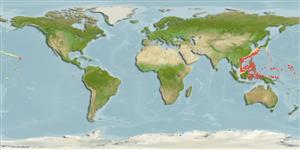Environment: milieu / climate zone / depth range / distribution range
Écologie
marin bathydémersal; profondeur 68 - 622 m (Ref. 10482). Deep-water; 40°N - 4°S, 107°E - 150°W (Ref. 92340)
Pacific: Taiwan, Vietnam, Philippines, Indonesia, and Hawaii; northernmost record Emperor Seamounts. Apparently restricted to the North Pacific (temperate to tropical) and reports from New Zealand and New Caledonia are based on misidentifications.
Taille / Poids / Âge
Maturity: Lm ? range ? - ? cm
Max length : 13.5 cm TL mâle / non sexé; (Ref. 28618); common length : 5.1 cm SL mâle / non sexé; (Ref. 10482)
Épines dorsales (Total) : 12; Rayons mous dorsaux (Total) : 9; Épines anales: 3; Rayons mous anaux: 5. Lachrymal bone consisting of 2 spines over maxillary, first as a broad lobe, second as a broad spine pointing down; well marked suborbital ridge with 5 or 6 or more spines; second preopercle spine small or absent (Ref. 10482). Distinguished from other Hawaiian scorpionfishes by having only the anterior 4 or 5 tubed lateral line scales present, with the remainder of the lateral line absent; and presence of large melanophores on the caudal peduncle (Ref. 10482).
Benthic (Ref. 58302). Feeds on small fishes and crustaceans (Ref. 5755). Female specimens (4.70-5.59 cm SL) taken from the Emperor Seamounts have mature gonads filled with relatively large eggs of several developmental stages with the most developed eggs are ca. 0.4 mm in diameter (Ref. 92340).
Life cycle and mating behavior
Maturité | Reproduction | Frai | Œufs | Fécondité | Larves
Paulin, C., A. Stewart, C. Roberts and P. McMillan, 1989. New Zealand fish: a complete guide. National Museum of New Zealand Miscellaneous Series No. 19. 279 p. (Ref. 5755)
Statut dans la liste rouge de l'IUCN (Ref. 130435: Version 2024-1)
Menace pour l'homme
Harmless
Utilisations par l'homme
Outils
Articles particuliers
Télécharger en XML
Sources Internet
Estimates based on models
Preferred temperature (Ref.
123201): 12.1 - 21.3, mean 16.2 °C (based on 121 cells).
Phylogenetic diversity index (Ref.
82804): PD
50 = 0.5156 [Uniqueness, from 0.5 = low to 2.0 = high].
Bayesian length-weight: a=0.01778 (0.00689 - 0.04588), b=3.04 (2.82 - 3.26), in cm total length, based on LWR estimates for this (Sub)family-body shape (Ref.
93245).
Niveau trophique (Ref.
69278): 4.0 ±0.66 se; based on food items.
Résilience (Ref.
120179): Haut, temps minimum de doublement de population inférieur à 15 mois (Preliminary K or Fecundity.).
Fishing Vulnerability (Ref.
59153): Low vulnerability (10 of 100).
